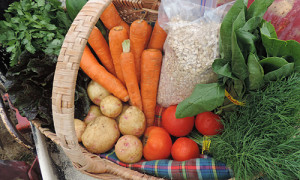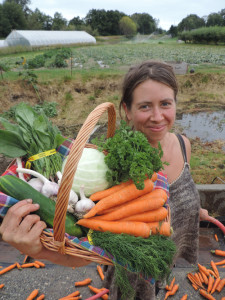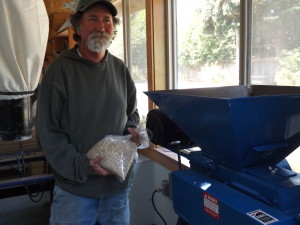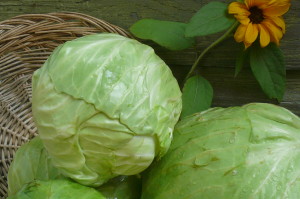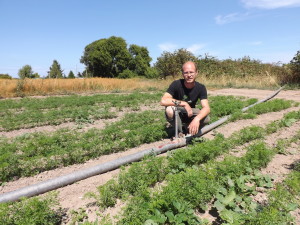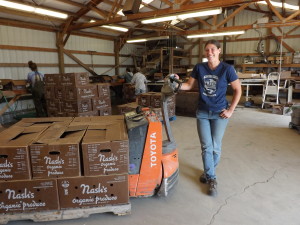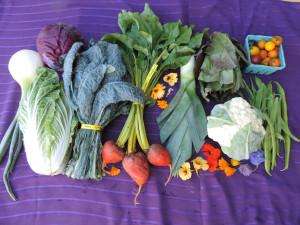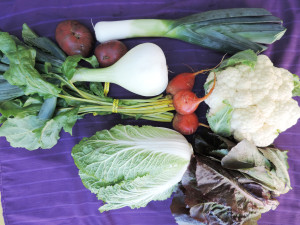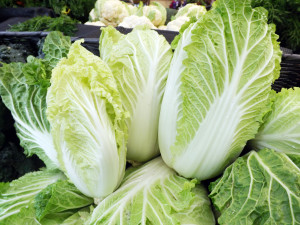Standard Box
Lemon cucumbers, 2
Red chard, 1 bu
Cilantro, 1 bu
Hard white wheat flour, 4 lbs
Garlic, .5 lb
Walla Walla onion
Curly parsley, 1 bu
Spinach, 1 bu
Zucchini or bulk beets, 2 lbs.
Nectarines, 2 lbs
Small Box
Basil, .25 lb
Lemon cucumbers, 2
Red beets with greens, 1 bu
Carrots, 1 bu
Red chard, 1 bu
Nectarines, 1 lb
Cherry tomatoes, 1 pt
Lemon Cucumbers
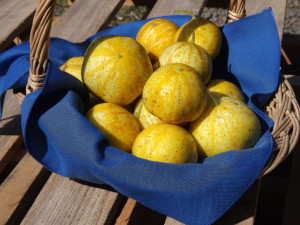
Round and yellow, this tennis ball-sized cucumber is a perfect serving for one or two people. Lemon cucumbers do not have a lemon taste, only the color. They have a thin, tender skin with a flavor a little milder than a regular cuke. Try hollowing out the cukes for a cold soup summer appetizer.
Cucumbers are one of the earliest cultivated food crops. They contain over 90% water, which is why they are so refreshing on hot summer days. They are also an effective diuretic.
Although cukes cannot boast tons of vitamin and mineral content, they do offer us benefits through the form of phytonutrients such as cucurbitacins, lignans, and flavonoids, which provide anti-oxidant, anti-inflammatory, and anti-cancer benefits. They also have a unique combination of lignans that offer anti-cancer properties as well as cardiovascular protection.
Lastly, cucumbers are a superior source of the mineral silicon, often lacking in our diets, but an integral component of calcium absorption. It may also play a role in bone and collagen formation.
Creamy Cucumber Salad
1/2 cup plain yogurt
Juice of 1 lemon, about 2 Tbsp.
2 Tbsp. chopped fresh dill, plus more for garnish (optional)
1–2 cloves garlic, minced
Salt to taste
4–6 cucumbers, lemon or standard (about 1 lb.), halved lengthwise and thinly sliced crosswise
In a medium bowl, combine yogurt, lemon juice, dill, and garlic. Season with salt , and whisk well with fork to combine. Add cucumbers, and toss to coat. Garnish with more dill, if desired. Serve immediately or refrigerate. Best eaten within a few hours.
Chard Frittata

Saute 1 small chopped onion and stems from 1 bunch chard in olive oil in a skillet with 1/2 tsp. dried basil and salt and pepper to taste until tender. Cover and stir occasionally. Add chopped chard leaves. Pack it in and replace lid. When shrunk, add 6 whisked eggs, stir quickly and press evenly in pan. Cover and turn heat down very low. Top with cheese and sprinkle with pepper. Cut with pie server when egg is cooked, and top with sauce:
1 cup yogurt
6 garlic cloves, minced
¼ cup parsley
¼ cream (optional)
Mix together and serve generously on chard frittata with fresh tomato. We thank Teri Crockett for this recipe.
Hard White Wheat
There are a myriad of types of wheat in the world, and sometimes their names can get quite confusing. In general,: hard red wheat is for bread and soft white wheat for pastries. But thanks for Tom Hunton, owner and operator of Camas Country Mill in the Willamette Valley in Oregon, we acquired a small quantity of an organic hard white wheat, and flour made from that wheat can be found in the Standard boxes this week.
Both hard varieties have hard starch granules (the endosperm where the gluten is found) that are larger and jagged-shaped so that they fit tightly together making the kernel strong and hard to crack or break. The soft starch granules of soft white wheat are small and round and break apart easily. Soft white also usually has a lower protein content than hard white or red.
Hard white wheat can be used for the same baked products as hard red wheat, but for some customers, color can be important, such as Asian restaurants looking for a bright white color for Asian noodles. Bakers the world over like hard white because it also has a naturally sweet flavor so they can use fewer sweeteners. Hard white wheat is an excellent ingredient for all yeast breads, artisan breads, Asian noodles, tortillas, pizza crusts, breadsticks, flatbreads, and quick breads.
In contrast, soft white is used mainly for bakery products other than bread, such as pastries, cakes, cookies, cereals, flat breads and crackers.


